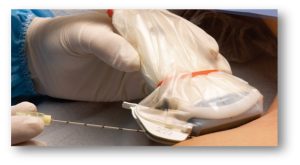Can A Needle Guide Simplify Ultrasound-Guided Procedures?

Since their introduction more than three decades ago, mechanical needle guides have been used to assist clinicians in the accuracy of placing needles for a variety of procedures such as biopsies, ablations, peripheral nerve blocks, vascular access, joint injections, and numerous others. But can a needle guide simplify the procedure? Can they reduce procedure times? Can they improve clinical confidence? Finally, and perhaps most importantly, can they improve patient safety? These are some important questions, so let's look at each one of them individually.
To learn more about how to needle guidance can aid ultrasound-guided interventions, join our webinar on Tuesday, April 9th at 1PM CT and earn 1.0 Vascular Technology (VT) SDMS CME. Registration Closed.
Do Needle Guides Simplify Ultrasound-Guided Procedures?

The placement of a needle into a patient, no matter the reason, is always a challenging and risky procedure. Needle visualization throughout the procedure is arguably the most important, and most challenging aspect of the procedure. Mechanical needle guides are engineered to keep the needle aligned within the sound beam of the ultrasound transducer. Some needle guides have predetermined angles of approach, as seen in figure 1.

Others are designed to allow the clinician to change the angle of approach during the procedure, as seen in figure 2. Which needle guide to using is often a personal preference, or is determined by the procedure being performed. Because of mechanical guides' ability to keep the needle within the sound beam for visualization by ultrasound throughout the procedure, needle guides can and do simplify procedures by:
- Improving needle visibility by as much as 54%1
- Decreasing access time by as much as 52.9%1
- Decreasing the overall number of needle passes and redirects1
- Increasing the success rate of first and second attempts1
Can The Use Of A Needle Guide Reduce Procedure Times?
Reduced procedure times are important for a variety of reasons;
- Increased productivity and workflow
- Less time that the needle or device is actually inside the patient
In a study published by Dr. Kim and his colleagues at The Royal Melbourne Hospital and the University of Melbourne in Australia, they reported a reduced TAP block procedure time by 12.8%2 when using a mechanical needle guide. Another study published by Dr's Babazade, Turan, and their colleagues at The Cleveland Clinic in Cleveland, Ohio reported a reduced procedure time for femoral blocks of 33%3 when using a mechanical needle guide.
Can The Use Of A Needle Guide Improve Clinical Confidence?
The clinical confidence necessary to perform an ultrasound-guided needle procedure comes from many different aspects, including training and experience levels, quality of sonographic images, and arguably the most important: the ability to visualize the needle throughout the procedure. In the aforementioned study by Dr. Kim and colleagues in Australia, they reported "this clinical study supports earlier simulation study which shows increased needle visibility, shorter procedural time and greater proceduralist satisfaction when using needle guidance device compared to the freehand technique in ultrasound-guided in-plane procedure"2.
Can The Use Of A Needle Guide Improve Patient Safety?
If a mechanical needle guide allows you to visualize where a needle is during a procedure, it also will allow you to see where your needle is not during a procedure. In other words, if we know the needle is where we want it to be, then we also know it is not where we do not want it to be.
This is important for a couple of reasons:
- If doing biopsy procedures, we can be confident the sample we are obtaining is from the correct area, (i.e. from the suspicious nodule), giving us confidence in the pathology results.
- Because the needle is visualized throughout the procedure, we can be sure that we are not coursing through an area we do not want to be, such as vessels or other organs.
The combination of reducing procedure times, increasing clinical confidence, decreasing needle passes and redirects, and improving first and second attempts all work toward improving patient safety. These clinical benefits can be achieved with the use of a needle guide during ultrasound-guided procedures.
For additional information on needle guidance systems join our webinar, "Ultrasound Guidance in Vascular Access," on Tuesday, April 9th, and earn complimentary SDMS CME or contact a CIVCO Representative at (800) 445-6741
References
- Maecken T, Heite L, Wolf B, Zahn PK, Litz RJ, "US-guided catheterization of the subclavian vein: free-hand vs. needle-guided technique" Anesthesia: The Association of Anesthetists of Great Britain and Ireland, 2015;1-8
- Kim C, Ratnayake M, Lethbridge G, Ng I (2014) "Comparing the Use of a Needle Guidance Device vs. Free-hand Technique in Performing Ultrasound- Guided TAP Blocks: A Prospective Randomised Trial", J Anesth Clin Res 5:429. doi: 10.4172/2155-6148.1000429
- Babazade R., MD; Turan A., MD; Nadar V., MD; CecilJ., MD; Elsharkawy H., MD, MSc; Wael ASE., MD, Soliman LM., MD; Seif J., MD; GeorgeJ., MD; Maheshwari K., MD, Farag E., MD; Zimmerman NM., MS; Sessler DI., MD Educational Exhibit: "Effect of InfinitiPlus Needle Guidance on Performing Ultrasound Guided Femoral Nerve Blocks" Department of Outcomes Research, Cleveland Clinic, Cleveland, OH




